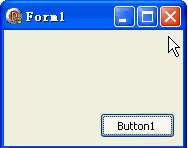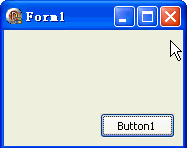CreateWaitableTimer( lpTimerAttributes: PSecurityAttributes; bManualReset: BOOL; lpTimerName: PWideChar ): THandle; ; SetWaitableTimer( hTimer: THandle; lpDueTime: TLargeInteger; lPeriod: Longint; pfnCompletionRoutine: TFNTimerAPCRoutine; lpArgToCompletionRoutine: Pointer; fResume: BOOL ): BOOL; ;
WaitableTimer 对象较复杂, 其基本的理念是让等候的线程在指定的时间运行.
像其他同类对象一样, 先要建立(CreateWaitableTimer), 建立函数的第二个参数决定是调度一个线程还是所有等候的线程; 这一点和信号对象(Semaphore) 有些类似, 不过 Semaphore 可以指定可驱动线程的具体数目.
和其他同类对象不同的是: 在 CreateWaitableTimer 以后, WaitableTimer 对象并没有马上开始工作;
再调用 SetWaitableTimer 函数后才能让它发挥作用. 这又有点像 Event 对象.
SetWaitableTimer 函数比较麻烦, 得慢慢来, 譬如这样使用:
hWaitableTimer: THandle;
TForm1.Button1Click(Sender: TObject);
DueTime: Int64;
hWaitableTimer := CreateWaitableTimer(, True, );
DueTime := ;
SetWaitableTimer(hWaitableTimer,
DueTime,
,
,
,
False
);
;
第一个例子我们将尽量简单的使用它(但这样体现不出它的优势):
CreateWaitableTimer 时我们就决定让它可控制多个线程;
SetWaitableTimer 时先让它立即参与控制, 只执行一次, 也不使用回调函数.
本例效果图:
代码文件:
Unit1;
Windows, Messages, SysUtils, Variants, Classes, Graphics, Controls, Forms,
Dialogs, StdCtrls;
TForm1 = (TForm)
Button1: TButton;
Button1Click(Sender: TObject);
FormDestroy(Sender: TObject);
;
Form1: TForm1;
f: Integer;
hWaitableTimer: THandle;
MyThreadFun(p: Pointer): DWORD; ;
i,y: Integer;
Inc(f);
y := * f;
WaitForSingleObject(hWaitableTimer, INFINITE) = WAIT_OBJECT_0
i :=
Form1.Canvas.Lock;
Form1.Canvas.TextOut(, y, IntToStr(i));
Form1.Canvas.Unlock;
Sleep();
;
;
Result := ;
;
TForm1.Button1Click(Sender: TObject);
ThreadID: DWORD;
DueTime: Int64;
hWaitableTimer := CreateWaitableTimer(, True, );
DueTime := ;
SetWaitableTimer(hWaitableTimer, DueTime, , , , False);
Repaint; f := ;
CreateThread(, , @MyThreadFun, , , ThreadID);
CreateThread(, , @MyThreadFun, , , ThreadID);
CreateThread(, , @MyThreadFun, , , ThreadID);
;
TForm1.FormDestroy(Sender: TObject);
CloseHandle(hWaitableTimer);
;
.
窗体文件:
Form1: TForm1
Left =
Top =
Caption =
ClientHeight =
ClientWidth =
Color = clBtnFace
Font.Charset = DEFAULT_CHARSET
Font.Color = clWindowText
Font.Height = -
Font.Name =
Font.Style = []
OldCreateOrder = False
OnDestroy = FormDestroy
PixelsPerInch =
TextHeight =
Button1: TButton
Left =
Top =
Width =
Height =
Caption =
TabOrder =
OnClick = Button1Click
下面是一个每隔半秒钟(500ms)执行一次的例子(窗体文件同上):
本例效果图:
代码文件:
Unit1;
Windows, Messages, SysUtils, Variants, Classes, Graphics, Controls, Forms,
Dialogs, StdCtrls;
TForm1 = (TForm)
Button1: TButton;
Button1Click(Sender: TObject);
FormDestroy(Sender: TObject);
;
Form1: TForm1;
f: Integer;
hWaitableTimer: THandle;
MyThreadFun(p: Pointer): DWORD; ;
i,y: Integer;
Inc(f);
y := * f;
i :=
WaitForSingleObject(hWaitableTimer, INFINITE) = WAIT_OBJECT_0
Form1.Canvas.Lock;
Form1.Canvas.TextOut(, y, IntToStr(i));
Form1.Canvas.Unlock;
;
;
Result := ;
;
TForm1.Button1Click(Sender: TObject);
ThreadID: DWORD;
DueTime: Int64;
hWaitableTimer := CreateWaitableTimer(, False, );
DueTime := ;
SetWaitableTimer(hWaitableTimer, DueTime, , , , False);
Repaint; f := ;
CreateThread(, , @MyThreadFun, , , ThreadID);
CreateThread(, , @MyThreadFun, , , ThreadID);
CreateThread(, , @MyThreadFun, , , ThreadID);
;
TForm1.FormDestroy(Sender: TObject);
CloseHandle(hWaitableTimer);
;
.
转载于:https://blog.51cto.com/rosehacker/450123




 本文介绍如何使用CreateWaitableTimer和SetWaitableTimer函数实现定时任务。通过创建WaitableTimer对象并设置定时器,可以让线程在指定时间运行。提供了一个简单示例和一个周期性执行的示例。
本文介绍如何使用CreateWaitableTimer和SetWaitableTimer函数实现定时任务。通过创建WaitableTimer对象并设置定时器,可以让线程在指定时间运行。提供了一个简单示例和一个周期性执行的示例。


















 89
89

 被折叠的 条评论
为什么被折叠?
被折叠的 条评论
为什么被折叠?








